Test drive nanoCAD SPDS Construction site 8. Part 1
- Tutorial
Test drive nanoCAD SPDS Construction site 8
We are starting to publish a test drive on nanoCAD SPDS Construction site. In the first part of the test drive, we will analyze the work with the special tool Project Manager, its main functions and methods of constructing elements of the construction plan. In the second part of the test drive, we will consider the construction of roads and the selection of equipment.

Theme 1. Work with the Project Manager
1.1. Adding a new work
1.2. Adding new work from the HESN classifier
1.3. Assignment of the associated cost and resources to work
1.4. Assignment of construction equipment to work
1.5. Assignment of material to work
1.6. Export of the project to the estimated program
1.7. Generation of a statement of volumes of work
1.8. Generation of statements of machines and mechanisms
1.9. Generation of a schedule of work
1.10. Generation of a schedule of needs for machines and mechanisms
1.11. Generation of a schedule of needs for workers
1.12. Generation of an explanatory note
Topic 2. Design of a construction plan
2.1. Construction site
2.2. The contour of the building being built
2.3. Identifier of a household town
2.4. Temporary buildings of a residential town
2.5. Explication of temporary buildings
2.6. Water supply network
2.7. Construction site fencing
2.8. Safety signs
Theme 1. Work with the Project Manager
In this topic, we will analyze the work with the special tool nanoCAD SPDS Construction site - Project Manager and consider its main functions. The manager is designed to compose a hierarchy of work, assign volumes and deadlines, as well as prices and resources for them. By compiled work, you can get a number of output documents.
To work, you will need the files "\ Theme 1_Project Manager \ Task \ Project Manager.dwg" and "Project Manager.xml", located in the same directory. When you open a drawing file, the project file is loaded automatically. To start the exercise, open the project manager.dwg file in nanoCAD SPDS Construction Site.
1.1. Adding a New Job
Call the Project Manager through the menu “Construction Site - Project Manager”. The project associated with this drawing file is loaded automatically and will be displayed in the Manager. On the “Jobs” tab, click the “Add job” button.
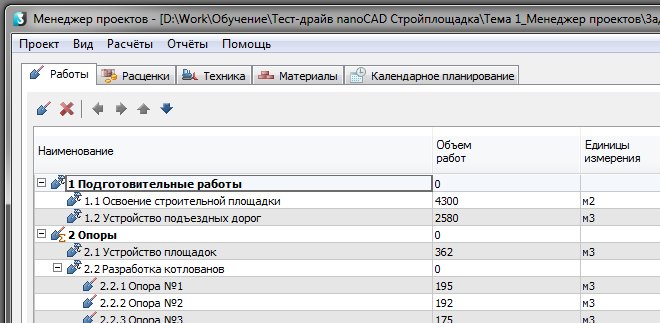
For new work, in the right part of the dialog enter the values shown in the figure.
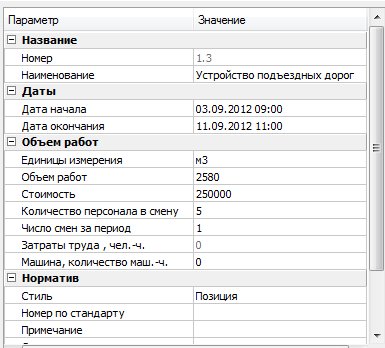
A new job takes its position in the structure of the work according to the position of the cursor at the time of its creation. To move the work to the desired location, use the buttons to move the work.
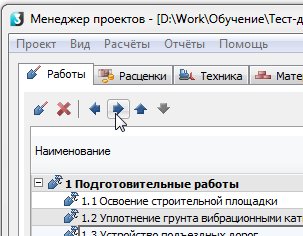
Move the work to section 3 “Spans” to position 3.6.
1.2. Adding a new work from the HESN classifier
Now we add the work not arbitrarily, but from the classifier of the SPES. In the classifiers section, we will open the GESN classifier, expand the 2017 edition, hereinafter referred to as “Part 1. Earthwork” - “Section 2. Other types of earthwork, preparatory, related and reinforcing” - “Subsection 2.1. Soil compaction ”-“ Compaction of the soil with 2.2 t vibratory rollers ”.
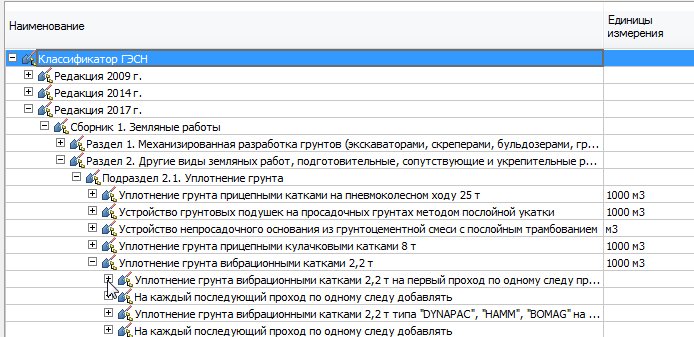
Position the cursor on this position and drag the work into section 1 “Preparatory work”. If necessary, use the work shift buttons to set it to position 1.2.
After that, set the units of measure - “m3” and the volume equal to 450 m3.
1.3. Assignment of associated pricing and resources to work
Switch to the “Pricing” tab of the Project Manager. Place the cursor on the added work “1.2. Compaction of the soil with vibration rollers 2.2 tons. " Make sure you have the classifier display turned on. To do this, in the "View" menu, check the appropriate settings.
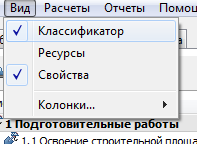
In the classifiers section at the bottom of the window, the “Related Rates” section will be displayed, if any, for this work. Open this section and select the rate "Compaction of the soil with vibratory rollers 2.2 tons for the first pass on one track with a layer thickness of 40 cm." While holding down the price with the left mouse button, drag it to work “1.2. Compaction of the soil with vibration rollers 2.2 tons. "
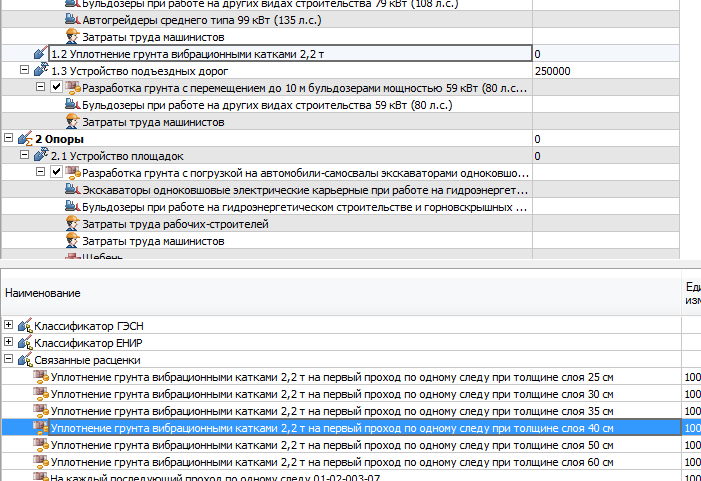
The price should be displayed with the assigned resources under the specified work.
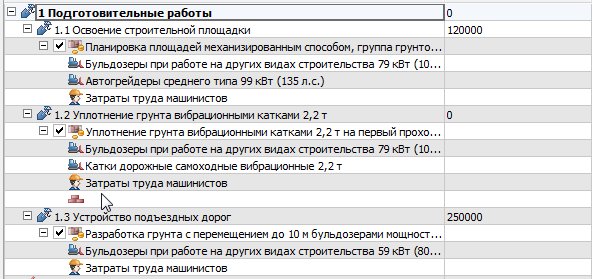
1.4. Assignment of construction equipment to work
Switch to the "Technique" tab. Place the cursor on the work “1.2. Compaction of the soil with vibration rollers 2.2 tons. " In the lower part of the window, select the category "Spare parts".

In this example, randomly select a bulldozer from the list and drag it to the right side of the dialog. A bulldozer will be assigned to work.

1.5. Assignment of material to work
To assign materials to the selected work, switch to the technician tab. In the list of works, select the work “2. Support”, in the classifier below select the desired material “Crushed stone, gravel” and drag it to work. It will appear in the list of materials on the right with the parameters already entered, except for the duration and values of material requirements.
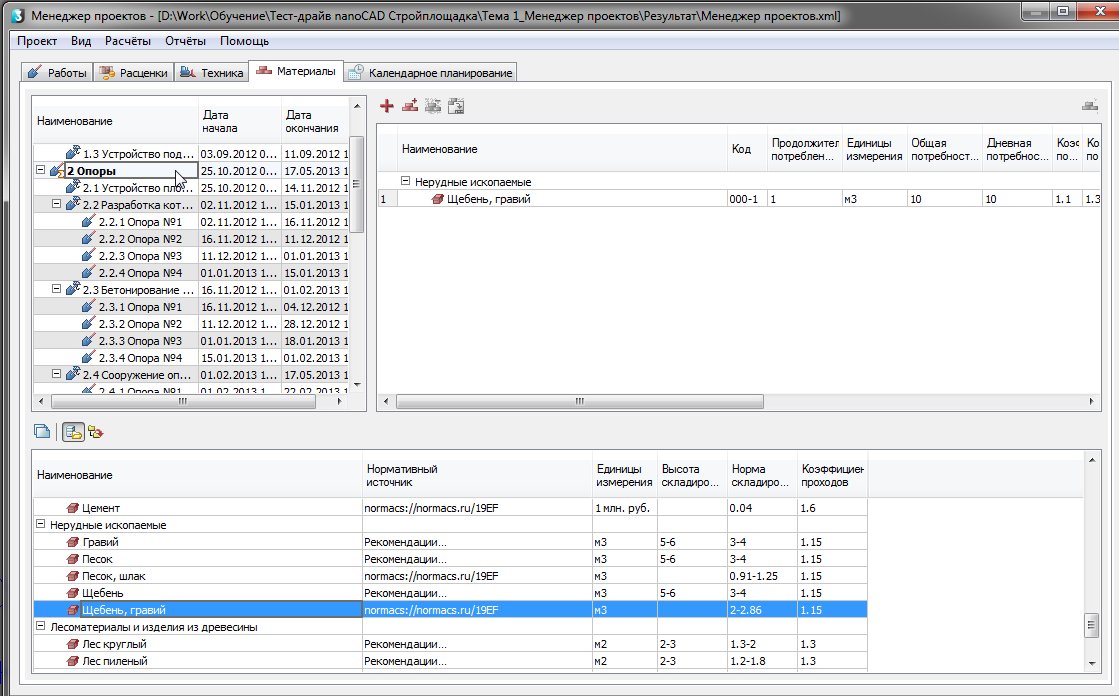
1.6. Export of the project to the estimated program
Works and the information assigned to them can be uploaded for transfer to estimated programs. There is a separate upload for the Grand Estimate program and to the universal data exchange format for estimated programs - ARPS.
To upload to the ARPS format, go to the Project-Export-ARPS 1.10 Manager dialog menu.

Save the file to your hard drive. Similarly, you can make an unloading for the Grand Estimate.
1.7. Bulk generation
Switch to the tab "Jobs" and select all the jobs using the keys Ctrl + A.
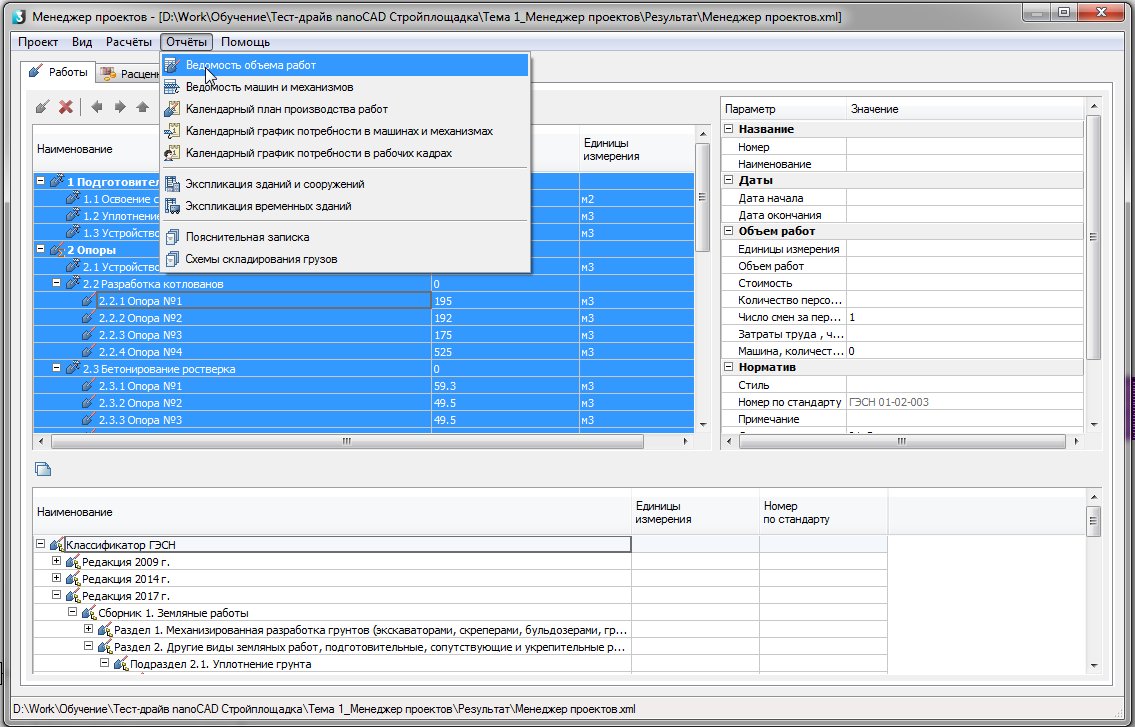
Next, run the command “Reports - Bulletin of work” and place the table in the drawing. You can also get a statement only for the marked sections and the works included in their composition.
1.8. Generation of statements of machines and mechanisms
In the same way, select all the work and run the command "Reports-List of machines and mechanisms." Place the table in the drawing.
1.9. Work schedule generation
Select all the jobs using Ctrl + A. Run the “Reports Schedule Work Plan” command. In the settings dialog, set the dates from 09/03/2012 to 07/28/2014. Group by month, filling by filling.
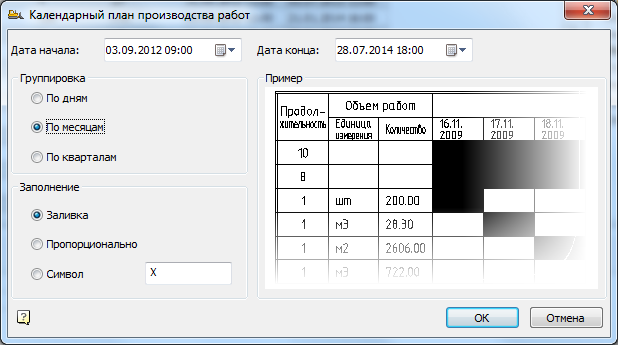
Place the resulting plan on the drawing.
1.10. Generation of a calendar schedule of the need for machines and mechanisms
The schedule can be obtained by analogy with the previous calendar plan.
1.11. Workforce demand calendar generation
Select all the jobs using Ctrl + A. Run the “Reports - Workforce Demand Schedule” command. Set dates from 09/03/2012 to 07/28/2014 in the schedule settings dialog. Wait for the graph to be generated and place it on the drawing. Below set the schedule of labor.
1.12. Explanatory Note Generation
Run the “Reports - Explanatory Note” command. Save the * .doc file to your hard drive, it will then open automatically.
Theme 2. Design of the construction plan
In this topic, we will look at ways to build elements of the construction plan in nanoCAD SPDS Construction Site .
To work, you will need the file "\ Theme 2_GHP Design \ Task \ CGP.dwg". During the exercises of this topic, we will run all the commands from the section of the main menu "Construction site-Stroygenplan", therefore further the teams will be written in abbreviation, without indicating this part of the path. To start the exercise, open the “SGP.dwg” file in nanoCAD SPDS Construction Site.
2.1. Construction site
From the menu "Site-Site Construction" run the command to build a construction site. This element serves as a conditional identifier for the construction site so that subsequent designations can be assigned to a specific site on the plan. In the dialog, select the icon “Construction site”. In the properties, indicate the name of the site - "Construction of a residential building", put the serial number - "1".
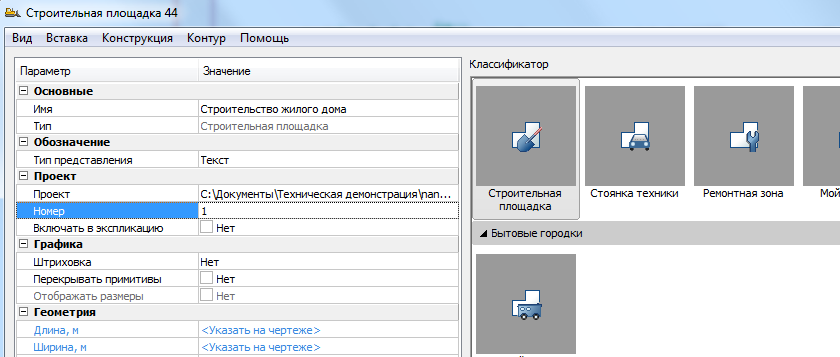
Next, in the drawing, indicate conditionally the boundaries of the site. This contour has nothing to do with real boundaries, because the object itself serves only as an identifier for other construction site objects. In the command options, select a rectangle construction and specify two diagonal points around existing drawing objects. The default site boundary is indicated in blue.
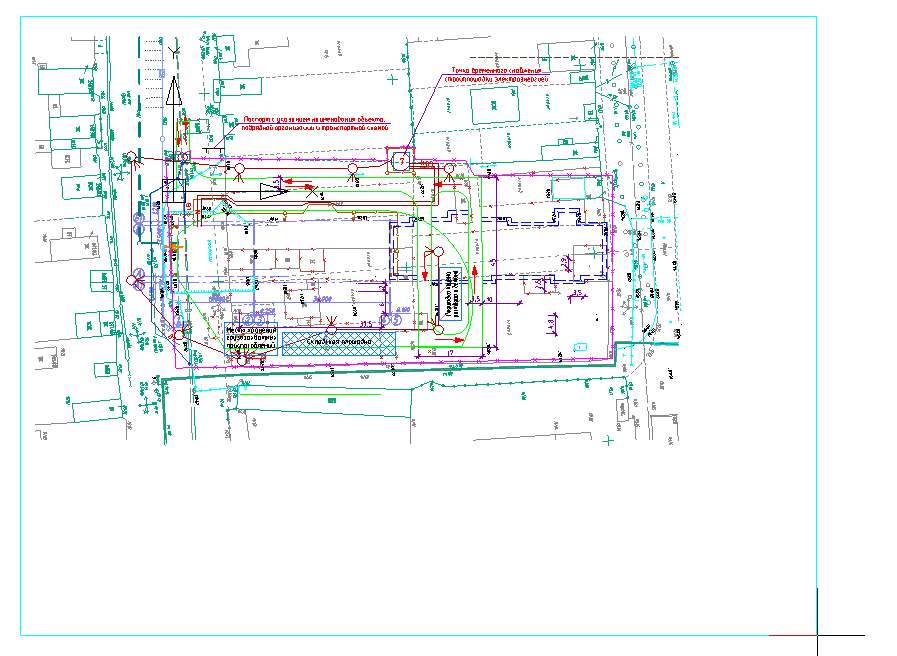
2.2. Outline of a building under construction
Build the contour of the building under construction. To do this, run the command “Buildings - Building under construction”. By default, the cursor in the classifier indicates the type of building we need. In the dialogue, indicate the name of the building - “Building being erected” and put the serial number “2” on it.
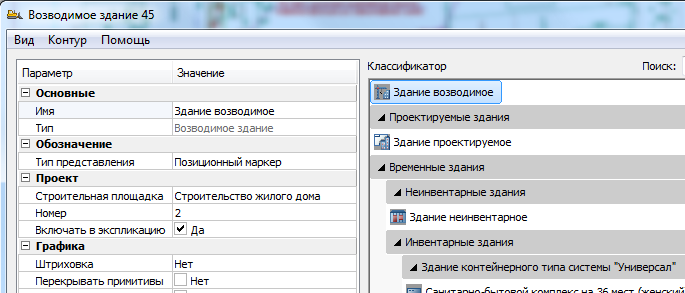
For ease of operation, select the method of building a rectangle in the command options. Specify the outline of the building as shown.
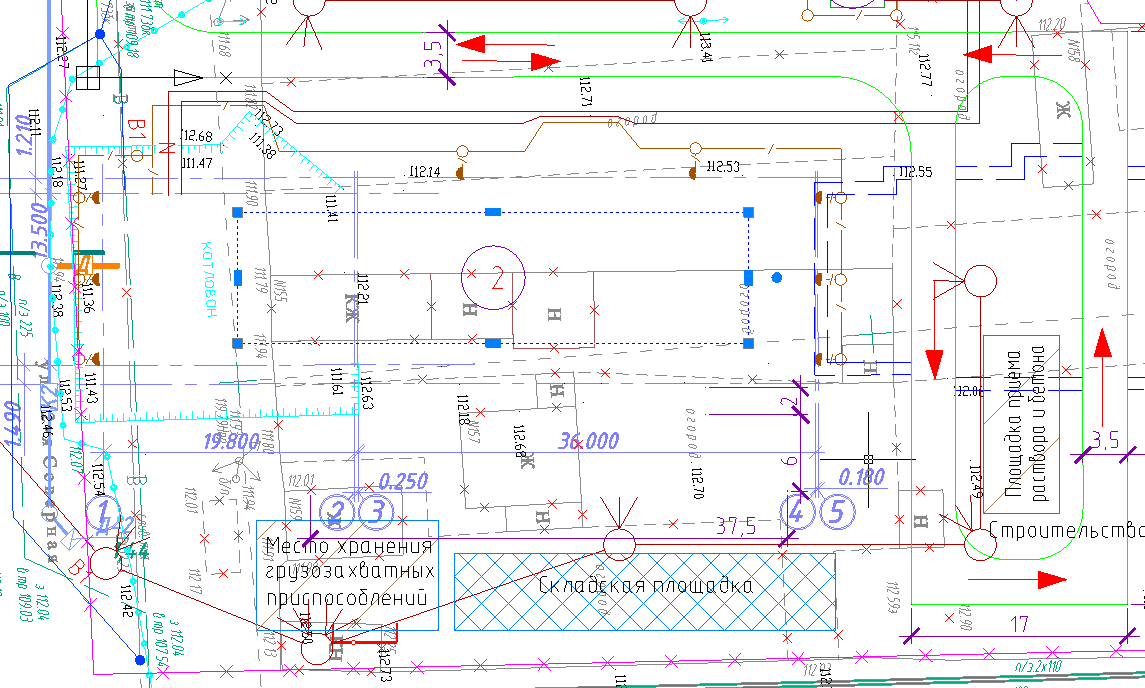
In this case, the dimensions of the building are indicated by us approximately, but in a real project everything is indicated exactly in size, using various construction methods.
2.3. House Town Id
The identifier of the household town plays a similar role as the identifier of the site. It serves to determine the affiliation of temporary buildings of a town to a specific town, because there can be several of them in the drawing. To add a household town, run the “Domestic Town-Domestic Town” command. In the dialogue, select the icon of the household town, give the name of the town - “Domestic town”, serial number “3”. Please note that the affiliation of the town to the construction site is indicated. In our case, it is one, so you do not need to change this parameter. For simplicity, select a rectangle construction method and indicate diagonal points in the drawing.
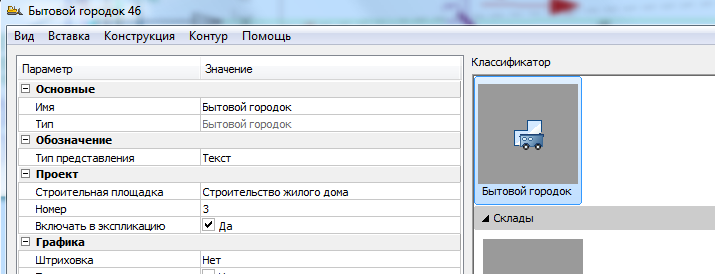
In our case, the boundaries of the household town are determined by us arbitrarily, as shown in the figure.
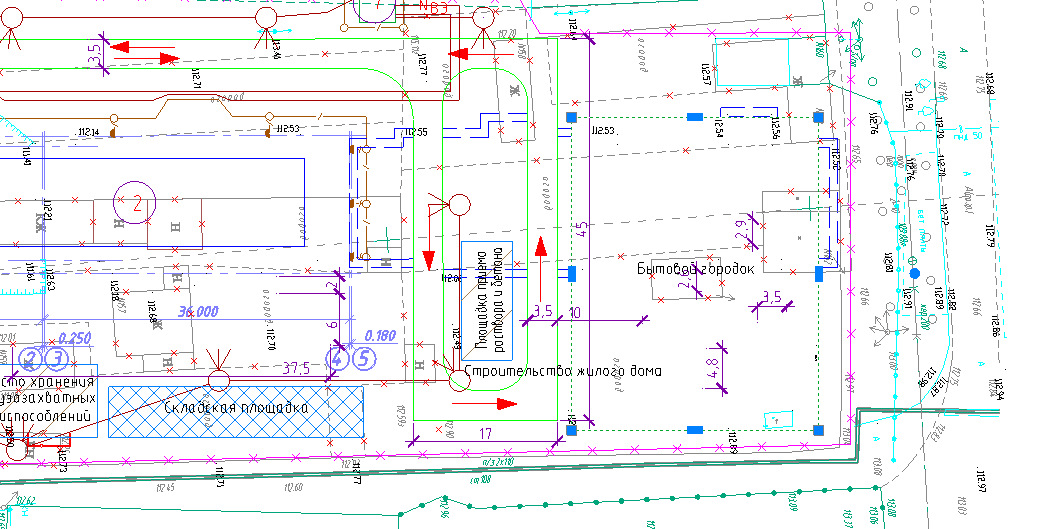
2.4. Temporary buildings of a residential town
For the household town we have defined, it is now necessary to affix temporary buildings. Run the team “Domestic town - Temporary building”. In the classifier, you can search by name. Select "Sanitary complex with 36 beds (male)." When setting the cursor, the name is transferred to the properties automatically. Please note that the building belongs to a previously defined household town. Make sure that the inclusion mark in the specification is set.

Set the serial number “1” for it and place it on the drawing within the boundaries of the town. Similarly, place other buildings, each time assigning the following serial number:
- Dining room with 36 seats;
- First-aid post;
- Construction headquarters;
- Toilet cabin "Standard";
- Transformer substation power up to 630 kW.
- In the picture you see the placed buildings of the household town with markers.
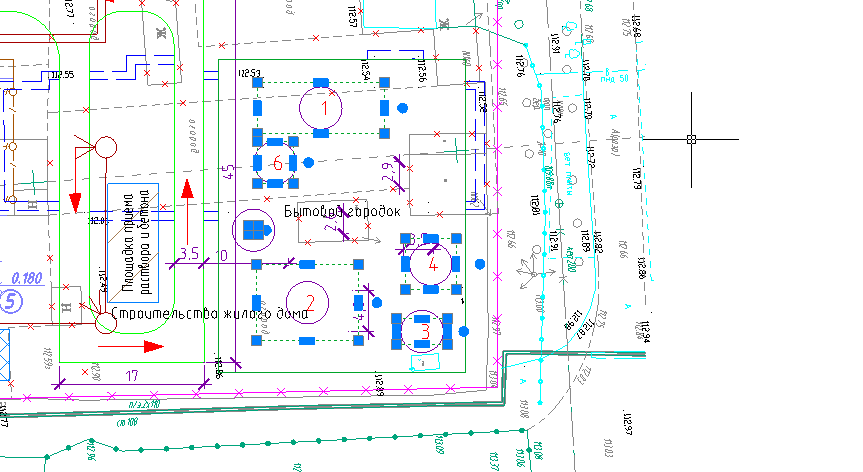
2.5. Explication of temporary buildings
Launch the Project Manager through the main menu of the program. In the Manager menu, call the construction of the explication through the menu "Reports - Explication of temporary buildings".
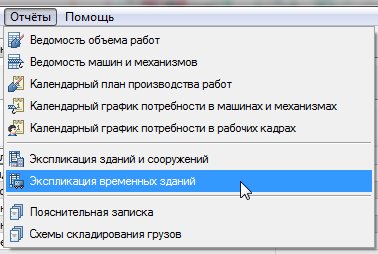
In the site selection dialog, select "Hometown".
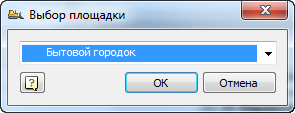
Place the explication in the drawing as shown.
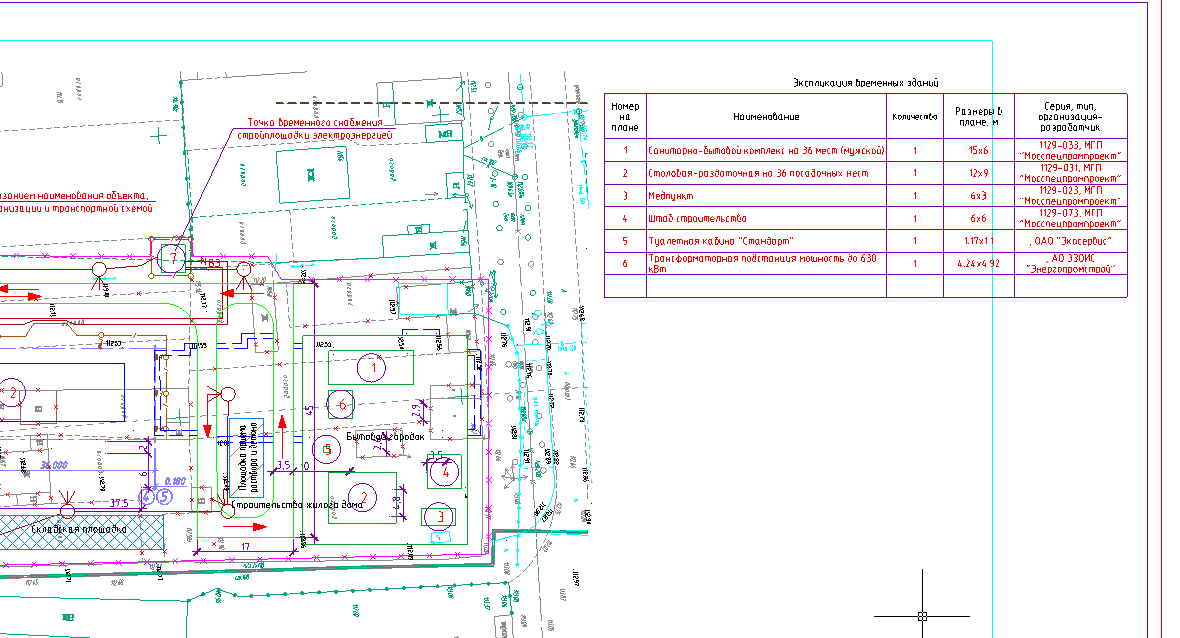
2.6. Water supply network
Put the designation of the external engineering network on the plan. Run the command "Networks - VK - Water Supply". In the dialog, select the icon “Temporary water supply network”. Pay attention to the belonging to the construction site.
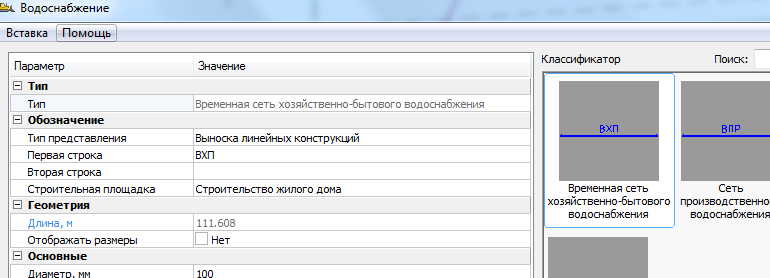
Build an arbitrary polyline on the plan. Select the line with the cursor. A special marker in the form of a cross will be visible next to the first indicated point. Click on this marker and build several wells along the line.

2.7. Construction site fence
Call the "Fences - Fences" command. You can arbitrarily select the type of fence and give it a name in the properties of the first and second lines. Draw a broken line of the fence around the construction site on the plan. Use the lock option when placing the last segment. On the constructed line, click a special marker in the form of a cross and put down the gate designations along the fence.
2.8. Safety signs
The commands for installing safety signs are called up through the main menu of the program “Construction Site - Signs - Safety Sign GOST 12.4.026”. You can search for the desired character by name. You can collect characters in a set and install them as a whole group in one command. In this case, select the characters and install them one at a time. In this exercise, select characters at random. To do this, find the desired character and double-click on it, place it in the "Selected characters" section at the top of the dialog.
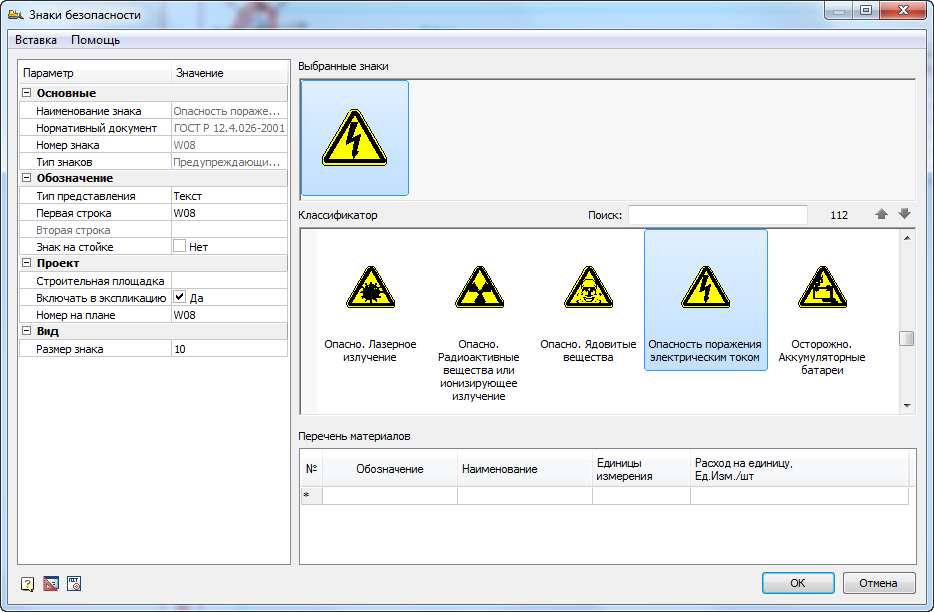
After that, click “OK” and place the character on the drawing. Repeat for several characters.
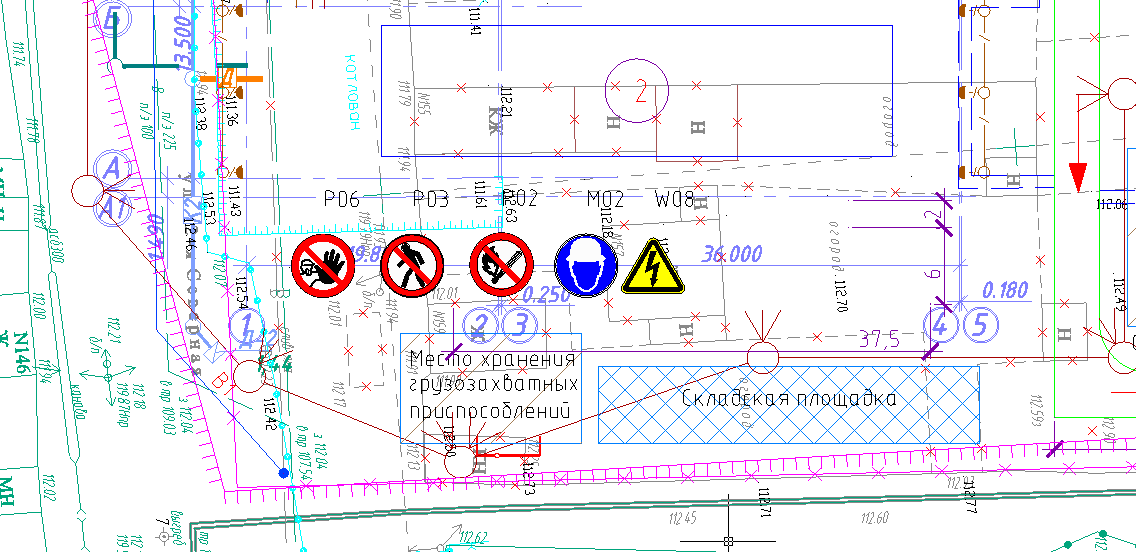
Run the command “Construction Site - Reports - Specification of Safety Signs”. Set the specification at the bottom of the drawing. The specification is interactive. You can, for example, delete one of the characters, and it will automatically update.
Recordings of past webinars can be viewed on our YouTube channel .
More information on spds.club
Olga Artemyeva, Head of Software Development

